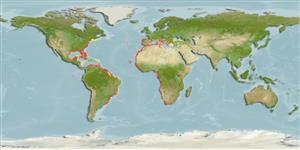Classification / Names
Common names from other countries
Main reference
Size / Weight / Age
Max length : 400 cm WD male/unsexed; (Ref. 3709); common length : 200 cm WD male/unsexed; (Ref. 3709); max. published weight: 60.0 kg (Ref. 4699)
Environment
Marine; brackish; demersal; depth range 5 - 100 m (Ref. 6808)
Climate / Range
Subtropical, preferred 27°C (Ref. 107945); 44°N - 35°S
Distribution
Western Atlantic: southern New England, USA, Brazil (Ref. 7251) to Argentina (Ref. 58839). Eastern Atlantic: Portugal to Ambriz, Angola (including the Mediterranean, Black Sea, and the Madeira and Canary islands).
Countries | FAO areas | Ecosystems | Occurrences | Introductions
Short description
Tail short armed with spine. Disk very broad. Very low dorsal and ventral finfolds on tail (Ref. 7251). Disk dark brown to grayish, lower surface of disc and of pelvic fins white, brownish, rosy or rusty cast. Tail white or rosy white below (Ref. 6902).
IUCN Red List Status (Ref. 115185)
Threat to humans
Harmless
Human uses
Fisheries: minor commercial; gamefish: yes
More information
ReferencesAquacultureAquaculture profileStrainsGeneticsAllele frequenciesHeritabilityDiseasesProcessingMass conversion
Tools
Special reports
Download XML
Internet sources
Estimates of some properties based on models
Phylogenetic diversity index
PD50 = 0.5001 many relatives (e.g. carps) 0.5 - 2.0 few relatives (e.g. lungfishes)
Trophic Level
4.5 ±0.1 se; Based on diet studies.
Resilience
Very Low, minimum population doubling time more than 14 years (Fec 4-7)
Vulnerability
Moderate to high vulnerability (51 of 100)
Price category
